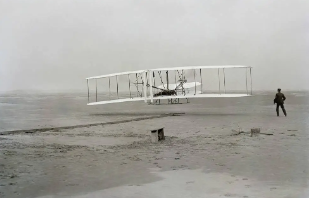Evolution of Aircrafts: From Ancient Egypt to Modern Drones and Solar Planes
Evolution of Aircrafts: From Ancient Egypt to Modern Skies
Whenever history of flight is discussed, most people begin with the Wright Brothers in 1903. Their fragile plane at Kitty Hawk is often celebrated as the first true aircraft. But if we look back in history, we find intriguing clues suggesting that the dream of flight started long before engines and propellers were ever invented.
 |
| Orville inside while Wilbur standing on right |
Archaeological finds like the Quimbaya gold figurines, the Temple of Seti carvings, and the Saqqara Bird show designs that strangely resemble modern aircraft. Personally, when I first came across these discoveries, I was amazed at how close some of these ancient objects look to the airplanes and helicopters we see today.
It makes you wonder: were these just coincidences, or signs of a deeper knowledge of flight?
The Quimbaya Gold “Aircraft” vs. Modern Fighter Jets and Drones
Over a thousand years ago, the Quimbaya civilization in present-day Colombia created golden figurines that continue to puzzle researchers. At first glance, they look like birds or insects, but the upward-pointing tails, vertical stabilizers, and low-set wings are not found in nature.
 |
| Quimbaya’s golden Artifact |
Modern comparisons make them even more fascinating. Their shape is strikingly similar to delta-wing fighter jets such as the Saab 37 Viggen, or even unmanned aerial vehicles (UAVs). When scaled replicas of the figurines were tested in wind tunnels, they glided successfully — behaving exactly like a miniature aircraft.
 |
| Saab 37 Viggen |
Looking at today’s cutting-edge aviation, the Quimbaya model also resembles compact military drones like the MQ-9 Reaper, which use fixed wings and stabilizers for long-range missions. The resemblance between Quimbaya’s golden artifact model and the silhouette of MQ-9 Reaper is insane.
 |
| MQ-9 Reaper |
To me, this is the most exciting part — the fact that a civilization with no known engines or science labs still created shapes that line up so perfectly with modern aircraft design.
The Temple of Seti Carvings vs. Helicopters and Tiltrotor Aircraft
In Abydos, Egypt, the walls of the Temple of Seti I are decorated with hieroglyphics that tell stories from over 3,000 years ago. Among them is a mysterious panel that some believe shows outlines of a helicopter, a submarine, and even what looks like a modern jet.
 |
| Hieroglyphics from Temple of Seti |
While many Egyptologists argue that these shapes are the result of overlapping carvings (a phenomenon called palimpsest), others see them as uncanny predictions of future technology.
If we compare the “helicopter-like” image with today’s AH-64 Apache, the resemblance is striking: a main rotor above the body, and an elongated tail section.
 |
| AH-64 Apache |
It also reminds me of modern tiltrotor aircraft like the V-22 Osprey, which combine helicopter-style vertical lift with airplane-like forward flight.
 |
| V-22 Osprey |
Whether coincidence or creativity, I find it fascinating that something carved thousands of years ago looks so close to machines we fly today.
The Saqqara Bird vs. Modern Gliders and Solar Aircraft
Perhaps the most compelling artifact is the Saqqara Bird, discovered near the Pyramid of Djoser. At first thought to be a simple toy or decorative carving, it was later examined by aerodynamics specialists. Unlike natural birds, its wings are flat and rigid, and its tail appears to have once supported an attachment.
 |
| Saqqara Bird |
When reconstructed and tested, the Saqqara Bird glided effortlessly through the air — similar to today’s sailplanes and gliders such as the Schweizer SGS 1-26. The balance, lift, and stability mirrored modern unpowered aircraft design.
 |
| Schweizer SGS 1-26 |
In fact, its simplicity also reflects features in futuristic solar-powered aircraft like Solar Impulse 2, which rely on lightweight frames, broad wings, and aerodynamic efficiency to stay airborne for long durations without fuel.
 |
| Solar Impulse 2 |
To me, the Saqqara Bird is an epitome that even a “toy” can hold hidden knowledge about flight mechanics.
The Timeless Dream of Flight
Do these artifacts prove that ancient civilizations could fly?
Not necessarily.
But they highlight an important truth: humans have always looked to the skies with wonder. The similarities between ancient objects and today’s aircraft show that imagination often precedes invention.
Related: Story of Polaris
From gold figurines shaped like jets, to carvings resembling helicopters, to wooden birds that glide like sailplanes — and even echo the designs of drones, tiltrotors, and solar aircraft — the evidence suggests that the dream of flight has been deeply rooted in human culture for millennia.
The Wright Brothers may have built the first powered plane, but perhaps their achievement was not the beginning of the story — rather, it was the continuation of a dream that started thousands of years earlier.
Personally, I see it as proof that human imagination is timeless: what was once just a carving or a figurine eventually became the real flying machines we now use every day.
References
- Smithsonian National Air and Space Museum
- Britannica
- NASA
- National Geographic


